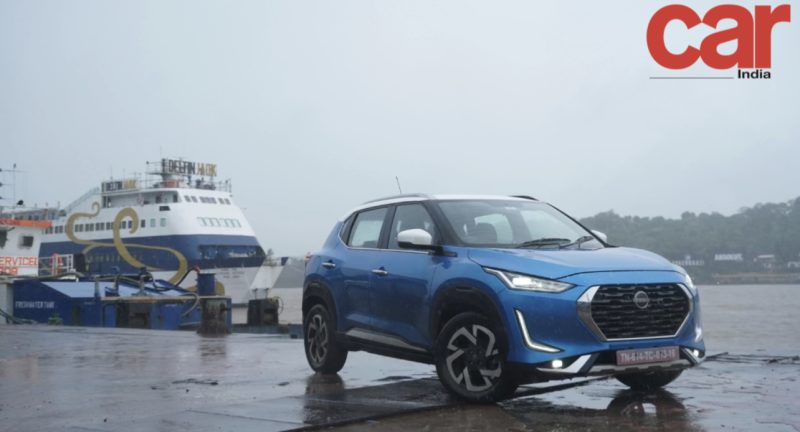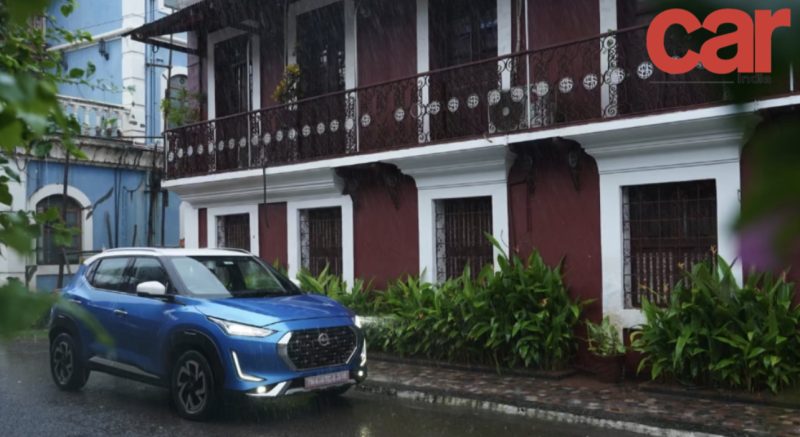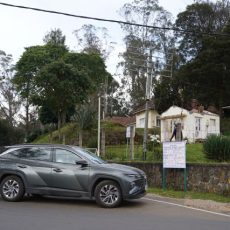Since Goa lies on the Konkan coast of India, where it frequently rains, you must visit Goa around June or July. The beauty of Goa is at its best during the monsoon. We set out to explore Goa in the monsoons season 
Story: Kurt Morris
Photography: Apurva Ambep
Goa’s coastline is almost 100 kilometres long, and its beaches have become quite well-liked vacation spots. But Goa offers much more than just the beach! It is wonderful from June to September when it is monsoon. The rain offers romance and relaxation, and Goa develops a more traditional feel as nature grows. You may experience the monsoon in Goa the traditional way if you go there during that time.

Our ride for this road trip was the Nissan Magnite in Vivid Blue with a Storm White roof that really stood out amongst the grey monsoon clouds. The Nissan Magnite is remarkable in every way. With the huge, brash, and gorgeous SUV, we got to see Japanese engineering in action. You’re hooked with just one glimpse. With its powerful lines and dynamic style, you may drive with complete assurance. The Nissan Magnite offers you opportunities that give you and your family extra space. Show off what it means to have that extra edge, whether it’s the 336-litre cargo capacity or the different utility storage for that weekend getaways like this Goa trip.

Coming back to our trip we set off from Pune and made our way to Panjim. The journey was promising with the beautiful roads and scenery which you traverse through crossing the stunning western Ghats Like Amboli and Chorla. Both the Ghats are a sight to see in the monsoons with plenty of waterfalls and the monsoon clouds which roll into the valleys make for a picturesque sight We covered a distance of 423 kilometres in about seven hours. We had to stop by the local eateries to gorge on some delicious Maharashtrian delicacies.

In terms of beaches, churches, carnivals, and scenic beauty, Panjim continues to be the most popular tourist destination in Goa. Since it is the state’s capital, Goa’s tourism industry is centred there. Beautiful Portuguese Baroque-style buildings with red, blue, green, and yellow roofs can be found throughout the town. You can enjoy the Goan culture while also seeing magnificent churches, alluring beaches, strong forts, and huge other Portuguese-influenced structures. Panjim is undoubtedly a city worth visiting to take in its breathtaking scenery and wonderful climate.
 Our first stop in Panjim was a church dedicated to Our Lady of the Immaculate Conception. Every day, the Church celebrates Mass in Portuguese, Konkani, and English. The first structure in the colonial Portuguese Baroque style was a chapel constructed in 1541 on a hillside overlooking the city of Panjim. The church’s iconic step has been a popular tourist landmark in Panjim and has been the backdrop in many Hollywood and Bollywood movies. It is definitely an Instagram-worthy photo opportunity.
Our first stop in Panjim was a church dedicated to Our Lady of the Immaculate Conception. Every day, the Church celebrates Mass in Portuguese, Konkani, and English. The first structure in the colonial Portuguese Baroque style was a chapel constructed in 1541 on a hillside overlooking the city of Panjim. The church’s iconic step has been a popular tourist landmark in Panjim and has been the backdrop in many Hollywood and Bollywood movies. It is definitely an Instagram-worthy photo opportunity.

After taking in one of the more popular sights in Panjim we made our way to a quieter part of Panjim, Fontainhas, also known as Goa’s Latin Quarter. Antonio Joao de Sequeira, a well-to-do Portuguese, founded Fontainhas in the late 18th century. He planted coconut trees on this land. However, the Portuguese government’s administrative centre was moved to Panjim in the early 1800s as a result of the plague that swept throughout Old Goa. As a result, this region became the home of the Portuguese kings and administrative officials. UNESCO designated Fontainhas as a Heritage Zone in 1984. Walking the streets of the Latin Quarter, takes you back in time to the colonial age.
 We wanted to get a bird’s eye view of Panjim so we headed to the Maruti Temple located atop the Altinho hill in Panjim, overlooking the Fontainhas neighbourhood. It is centric to Lord Hanuman, the monkey god, the presiding deity, and is dedicated to him. The Maruti Temple is also exquisitely illuminated at night, and because of its dazzling illumination, it is noticeable from a distance. The temple is perched on a small hill, offering a bird’s eye view over Panjim’s eastern neighbourhood, the surrounding communities of Ribandar and St. Cruz, as well as the River Mandovi and its mangroves.
We wanted to get a bird’s eye view of Panjim so we headed to the Maruti Temple located atop the Altinho hill in Panjim, overlooking the Fontainhas neighbourhood. It is centric to Lord Hanuman, the monkey god, the presiding deity, and is dedicated to him. The Maruti Temple is also exquisitely illuminated at night, and because of its dazzling illumination, it is noticeable from a distance. The temple is perched on a small hill, offering a bird’s eye view over Panjim’s eastern neighbourhood, the surrounding communities of Ribandar and St. Cruz, as well as the River Mandovi and its mangroves.

Having taken in all the sights we worked up a big appetite. Without eating at Martin’s Corner, no visit to Goa is complete, So we had to come and savour the delicious food. In 1989, the late Mr. Martin Pereira opened Martin’s Corner as a corner store in the neighbourhood. It has developed into one of Goa’s most well-known and often visited multi-cuisine restaurants for authentic Goan cuisine and seafood. Seafood is well known for being accessible in traditional Goan, North Indian, Continental, and Oriental cuisines. A must-have in the wet Goa climate. With potatoes, ginger, garlic, turmeric, peppercorns, cloves, cinnamon, and more, small meat chunks were cooked! Chilly meat from Goa. Shrimp Curry Rice is placed on top of rice that has been prepared with local spices and coconut curry. A need whenever you visit Goa. However, the enormous fish platter had to be the centre of attention: it had an array of seafood options ranging from lobster to crab and even a whole fish fry.

The meal at Martin’s Corner definitely put us into a food coma, so we wanted to find something laid back and sort of a hidden gem away from the major tourist attractions, so we headed over to the “Houses of Goa Museum”. A local architect, Gerard da Cunha, came up with the idea for the museum after using it as the basis for an international trade show. Given its rarity and the level of curiosity among the tourists, he made the decision to pursue this as a stand-alone museum. He is currently the director of design and main curator of the Houses of Goa Museum. Because of its ship-like shape and location in the middle of the road, the museum stands out. What is even more surprising is that there is a spiral staircase instead of a straight flight of stairs when you enter. You get the impression that you are climbing a ship’s mast pole.
 The Museum marked our last stop on this road trip, where we set out to explore Goa and see what goa has to offer in the monsoons. Our time with the Nissan Magnite was a pleasant experience. You only need to push the start button to turn on the ignition in the Nissan Magnite for the HRA0 1.0-litre engine to start pumping power through the SUV. Over the entire length of the journey, we spent a lot of time in the interiors of the NissanConnect which offers more than 50+ features, Smartwatch Connectivity, 24-hour road side safety assistance, and convenience. Make your fashion statement stand out even though the Nissan Magnite is sure to do so.
The Museum marked our last stop on this road trip, where we set out to explore Goa and see what goa has to offer in the monsoons. Our time with the Nissan Magnite was a pleasant experience. You only need to push the start button to turn on the ignition in the Nissan Magnite for the HRA0 1.0-litre engine to start pumping power through the SUV. Over the entire length of the journey, we spent a lot of time in the interiors of the NissanConnect which offers more than 50+ features, Smartwatch Connectivity, 24-hour road side safety assistance, and convenience. Make your fashion statement stand out even though the Nissan Magnite is sure to do so.
Also Read: https://carindia.in/nissan-magnite-red-edition-launched-in-india/
Story by Kurt Morris




